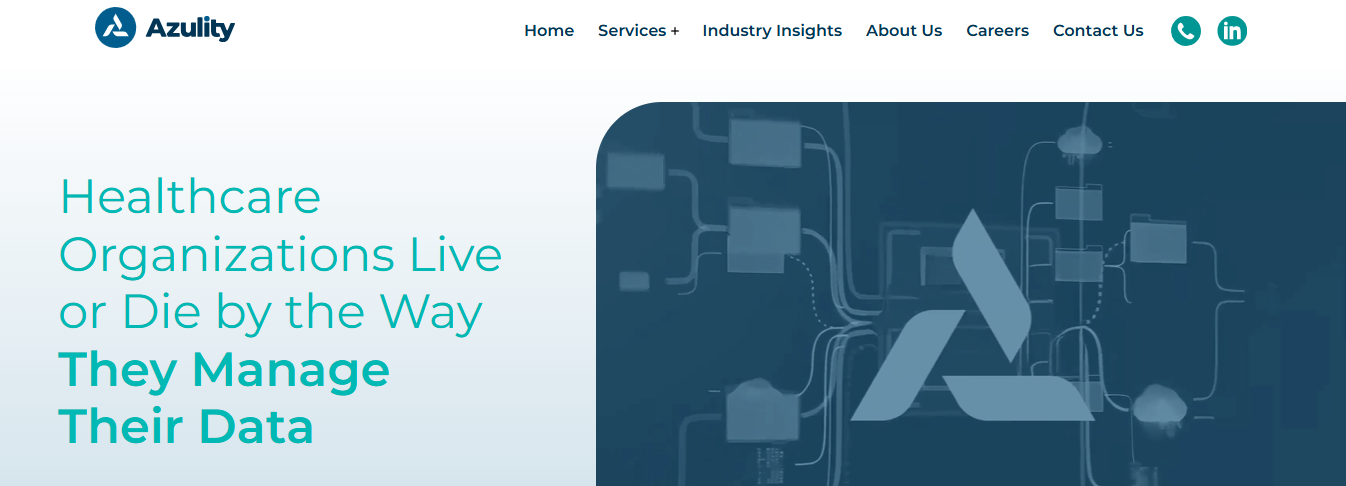No one enjoys staffing issues in healthcare. Filling an empty position takes an average of three months, and the longer a vacancy remains unfilled, the more chaos and stress it creates for the entire healthcare team. Resource allocation in healthcare is not abstract; it has real-life repercussions for medical professionals and patients. When a healthcare organization is short-staffed, the quality of patient care suffers significantly.
This guide will help you address your goals, such as allowing healthcare services with credentialing, better managing resource allocation, and avoiding staffing shortages. One way to achieve these goals is to utilize Azulity’s provider credentialing services. Our solution streamlines credentialing so healthcare organizations can quickly onboard qualified professionals to fill open positions.
Reasons for Healthcare Workforce Shortage


Staff Turnover: A Major Contributor to Healthcare Staffing Shortages
High turnover rates significantly contribute to healthcare staffing shortages. Research shows that 80% of healthcare providers report turnover rates of 11-40%, and nearly 10% report turnover rates between 41-60%. Causes of staff shortages existed even before the COVID-19 pandemic. An aging Baby Boomer population and limited training opportunities in areas like nursing led to predictions of looming staff shortages.
The pandemic exacerbated the situation, leading to a mass exodus of workers and The Great Resignation. Some reports show healthcare lost 20% of its workforce, including 30% of nurses. Today, the average hospital turns over one-quarter of its staff annually, an increase of more than 6% from the prior year. As a result, the State of Patient Access 2023 reported that nearly 50% of providers say access to care is worsening.
Recruitment and Hiring: Healthcare’s Staffing Crisis Burdens Organizations
Finding and hiring staff is a burden for healthcare providers. A staggering 73% of respondents said finding qualified staff is complex, and 61% reported that meeting entry-level staff’s salary expectations is challenging. Healthcare organizations feel the staffing crisis at every level. A recent Medical Group Management Association (MGMA) poll cited the difficulties in hiring revenue cycle staff: 34% of respondents stated hiring medical coders is their biggest challenge. 26% said that billers were difficult to find.
One-third said finding schedulers and prior authorization staff is hard. Other hiring challenges included revenue cycle management (RCM) managers. When and if healthcare providers find staff, bringing them into the fold is costly. Experian Health’s staffing survey showed most organizations struggle to meet the salary expectations of even the least experienced members of their teams.
Burnout: The New Norm and a Top Contributor to Staffing Shortages
Burnout is a top contributor to healthcare staffing shortages. 53% of poll respondents said staff burnout is a key cause of the current staff shortage. 48% said the new expectation for schedule flexibility and hybrid work models also contributes to the healthcare workforce shortage. The latest data show the percentages of clinical and administrative burnout in healthcare are approaching or exceeding 50% in most job categories: 56% of nurses report burnout symptoms, 54% of clinical staff, 47% of doctors, and 46% of non-clinical staff.
Cost-cutting and increasing care demands have led to increasing fatigue in healthcare staff. However, technology exists to automate back office functions, which could free up staff time. For example, organizations like Kootenai Health saved nearly 60 hours of staff time in over 8 weeks by automating the presumptive charity process, Patient Financial Clearance. Stanford Health used Collections Optimization Manager to cut 672 monthly hours from overburdened back office staff.
The COVID pandemic also changed expectations about how and where Americans should work. Remote work became normal; three years post-COVID, 58% of the American workforce reports working remotely at least one day a week. The same data also shows that when workers have the chance to work virtually, 87% take it. Healthcare is not immune to the desire for more schedule flexibility.
Becker’s Hospital Review states, “Many workers desire the ability to work remotely, even if they only get the option a few days a week. Flexibility allows people to maintain work-life balance—and in a high-burnout field like healthcare, balance can be crucial.” Surveys show that 31% of healthcare roles are remote full-time, while 14% offer this flexibility in part-time. The problem is that many healthcare positions cannot allow this flexibility, and the industry competes with others that do.
Azulity specializes in healthcare master data management and provider credentialing services, bringing proven expertise in implementing healthcare data solutions and credentialing across the US. Our comprehensive platform ensures consistent patient, provider, location, and claims data synchronization across all systems and departments.
Key features include: healthcare MDM, provider MDM, reference data management, credentialing, and provider enrollment. We serve healthcare technology leaders – from CIOs and CDOs to VPs of data platforms and credentialing – helping them eliminate the costly problems of fragmented data systems. Book a call to learn more about our healthcare master data management services today!
Impact of Healthcare Workforce Shortage
![]()
![]()
Staffing shortages in healthcare significantly compromise patient safety and the quality of care. There are several impacts:
1. Increased Risk of Violence and Aggression
A lack of therapeutic interventions due to understaffing can lead to heightened incidents of violence and aggression on wards. Chronic shortages hinder staff’s ability to respond effectively, sometimes resulting in untrained personnel assuming responsibilities beyond their qualifications, thereby boosting the risk of developing closed cultures.
2. Diminished Access to Therapeutic Care
Staffing deficits have reduced patient involvement in care decisions, led to fewer ward activities, and canceled patient leave, all of which are critical for effective treatment and recovery.
3. Compromised Patient Safety
Understaffing can result in missed observation checks and inadequate incident responses, jeopardizing patient safety. For instance, patients have reported that observation checks were regularly missed due to staff being too busy.
Additionally, reports from other healthcare settings underscore similar concerns. For example, an audit of Maryland’s correctional facilities revealed that understaffing contributed to missed suicide risk evaluations and insufficient mental health exams, compromising inmate care.
These findings collectively emphasize the urgent need to address staffing shortages to ensure the delivery of safe, effective, and patient-centered healthcare.
Related Reading
11 Healthcare Workforce Shortage Solutions


1. Equip the Potential of Technology Like Azulity
Azulity specializes in healthcare master data management and provider credentialing services. They bring proven expertise in implementing healthcare data solutions and credentialing across the US. Their comprehensive platform ensures consistent patient, provider, location, and claims data synchronization across all systems and departments. Key features include healthcare MDM, provider MDM, reference data management, credentialing, and provider enrollment. They serve healthcare technology leaders, from CIOs and CDOs to VPs of data platforms and credentialing. Their help eliminates the costly problems of fragmented data systems.
2. Make Employee Satisfaction a Priority
It’s no secret that healthcare work can be challenging. There are physical and mental health concerns that come with caring for sick individuals, especially during and in the aftermath of a global pandemic. To help address this issue, prioritize employee satisfaction. Give your employees the resources to succeed by listening to their concerns and responding attentively.
Remind employees to take time off for self-care and offer flexible scheduling. As a company, try offering open forums where employees can address their concerns and feel heard when they need assistance. By giving your employees the consideration and attention they need, you can work to avoid widespread burnout and potential staffing shortages. Remember to encourage healthcare workers to care for themselves and create healthy boundaries. Setting a positive tone in the workplace is an excellent step toward addressing staffing issues in healthcare.
3. Promote Cross-Training Among Employees
Cross-training develops a versatile workforce that can mitigate the impact of absences or shortages. If you lose staff to illness or turnover, trained employees can smoothly step in to handle critical tasks and keep operations running smoothly. Ensure employees receive comprehensive training and ongoing support to step into different positions when necessary.
4. Regularly Review and Improve Workflows
Regularly assess your operational processes to identify inefficiencies and bottlenecks. Analyze administrative tasks and pinpoint areas where automation or streamlining can be implemented. Standardize procedures and eliminate unnecessary steps to optimize workflows. By optimizing workflows, you can maximize productivity and reduce stress on your staff. Here are two websites you can explore and implement strategies for continuously reviewing and improving workflows:
Trello
Trello is a web-based project management tool that can streamline workflows and enhance collaboration. With Trello, you can create boards, lists, and cards to map out your processes visually. It allows you to assign tasks, set deadlines, and track progress, making it easier to identify bottlenecks and inefficiencies in your workflows. Using Trello, you can continuously review and improve your operational processes, enhancing productivity and reducing stress for your staff.
Lean Six Sigma Institute
The Lean Six Sigma Institute offers a comprehensive approach to process improvement. Their website provides resources, training, and tools to implement Lean and Six Sigma methodologies, which focus on eliminating waste, improving efficiency, and standardizing procedures. By adopting Lean Six Sigma principles, medical practices can identify and address workflow inefficiencies, optimize processes, and enhance productivity.
5. Hire the Right People
The hiring process is critical in setting employees up for success. Now is the time to examine your hiring and HR processes and look for gaps or weaknesses. Even if employees have the right qualifications, this doesn’t mean they’re suited for all open positions. Be honest and upfront about job expectations from the beginning of the hiring process.
Make sure to outline daily processes, such as scheduling, routine duties, and the working environment. Consider giving potential employees a chance to visit your site to understand better how your healthcare system works. If you don’t recruit and hire properly, you may face high turnover rates and staffing shortages that can create instability in the workplace.
6. Utilize Temporary Staffing Solutions
Temporary staffing can be an effective short-term solution to manage staffing shortages. By leveraging the services of temporary staffing agencies, you can gain access to a pool of qualified temporary staff to cover gaps in your workforce. Consider the following steps:
Partner with a Reliable Staffing Agency
Choose a reputable staffing agency specializing in the medical field. Work closely with the agency to communicate your specific needs, preferences, and requirements. Collaborate to establish clear expectations regarding the roles and responsibilities of temporary staff members.
Maintain Open Communication
Communicate regularly with the staffing agency to provide feedback on temporary staff’s performance. Provide clear instructions and guidelines to ensure smooth integration within your medical practice. Open communication ensures that temporary staff can quickly adapt to your practice’s unique requirements.
Assess the Potential for Permanent Hires
While utilizing temporary staff, be open to identifying potential long-term employees. Observe their performance, work ethic, and cultural fit within your practice. Consider temporary staff for permanent positions while building a skilled and committed team.
7. Upgrade Training Processes
When organizations are understaffed, the need to quickly hire emerges. However, hiring workers too fast can overwhelm existing employees who help train new hires. Examine your current training processes to look for gaps and weaknesses that may not prepare workers appropriately. If your training processes don’t fully address the needs of new workers, they may be discouraged from the start.
Talk to other employees about where training can improve and incorporate their feedback where possible. Take input from your HR department to check for recurring issues or concerns from your latest hires. Training sets the tone for how your workplace operates. By ensuring this process is comprehensive and smooth, you can work to address and combat staffing issues in healthcare.
8. Introduce Telemedicine Services
Telemedicine allows healthcare professionals to remotely provide consultations, follow-ups, and triage services. By implementing telemedicine, you can reduce the need for in-person visits and optimize the use of available staff. Explore various telemedicine platforms and choose one that best suits the needs of your medical practice and patients.
9. Implement Patient Self-Service Tools
Allow patients to take an active role in managing their healthcare by implementing patient portals and self-service tools. These tools enable patients to schedule appointments, access medical records, and complete necessary paperwork online. By providing self-service options, you can reduce the administrative burden on staff, freeing up their time for more critical tasks.
10. Embrace Electronic Health Records (EHR) Systems
Implementing an EHR system improves the accuracy, accessibility, and efficiency of medical records. By digitizing patient information, you eliminate the need for extensive paperwork and streamline administrative processes. Ensure your staff receive proper training to utilize the EHR system effectively and maximize its benefits.
11. Foster Community Partnerships
Collaborating with local educational institutions and community organizations can provide access to a talent pipeline and additional resources during staffing shortages. Consider the following approaches:
Establish Internship Programs
Forge partnerships with local medical schools, colleges, and vocational institutions to create internship programs. Under supervision, interns can assist with non-clinical tasks, gaining valuable experience while contributing to the smooth operation of your practice. This partnership provides an opportunity to assess potential long-term hires while supporting the development of future healthcare professionals.
Engage with Volunteer Networks
Connect with local volunteer networks, such as community organizations or retired professionals, to recruit individuals who can assist with administrative tasks and support during peak periods or staff absences. Volunteers can contribute their time and expertise to alleviate the strain on your existing staff and ensure uninterrupted patient care.
Advanced Healthcare Workforce Shortage Solutions


1. Speech-to-Text Applications: Easing Administrative Tasks for Healthcare Workers
These applications convert voice into text to help reduce the paperwork a medical professional must complete. With accuracy rates of up to 85%, apps like Nuance streamline documentation so clinicians can spend more time on patient care.
2. Voice Assistants: Reducing Staff Workloads Through Automation
Devices like Amazon’s Alexa enable hands-free patient monitoring and communication to decrease the need for in-person interactions. This technology helps staff manage their workload more efficiently, improving overall operational productivity.
3. Telemedicine: Alleviating Healthcare Staffing Shortages
Telemedicine allows remote diagnosis and care, which helps decrease patient load in clinics. This frees up time for healthcare providers and facilitates better coordination with specialists.
4. Portable Patient Monitoring Devices: Improving Patient Care and Reducing Staff Burden
These devices track vital signs on the move and alert caregivers to emergencies, integrating with EMR health systems to ensure continuous monitoring. This technology supports patient care while alleviating some burdens on overtaxed staff.
5. Queue Management Systems: Optimizing Patient Flow
These systems predict busy times and help manage schedules to improve patient flow. By reducing wait times and enhancing appointment efficiency with real-time updates, they help relieve some of the pressures associated with healthcare staffing shortages.
Azulity specializes in healthcare master data management and provider credentialing services, bringing proven expertise in implementing healthcare data solutions and credentialing across the US. Our comprehensive platform ensures consistent patient, provider, location, and claims data synchronization across all systems and departments.
Key features include: healthcare MDM, provider MDM, reference data management, credentialing, and provider enrollment. We serve healthcare technology leaders – from CIOs and CDOs to VPs of data platforms and credentialing – helping them eliminate the costly problems of fragmented data systems. Book a call to learn more about our healthcare master data management services today!
Related Reading
- Employee Retention in Healthcare
- Recruitment Challenges in Healthcare Industry
- Healthcare Data Analyst Requirements
Book a Call to Learn More About Our Provider Credentialing Services


Healthcare organizations, both large and small, are struggling to manage the staffing crisis. As employees leave or reduce their hours, healthcare facilities must bring on temporary or permanent replacements to fill the gaps. Either way, these new hires must be credentialed to ensure they can provide safe and effective care.
Every time a new employee, locum tenens, or traveling nurse is hired, a facility will experience a disruption in operations, and it can take weeks or months for things to return to normal. Azulity’s master data management solutions can streamline the process of credentialing and onboarding new staff so that healthcare organizations can get back to business as usual.
